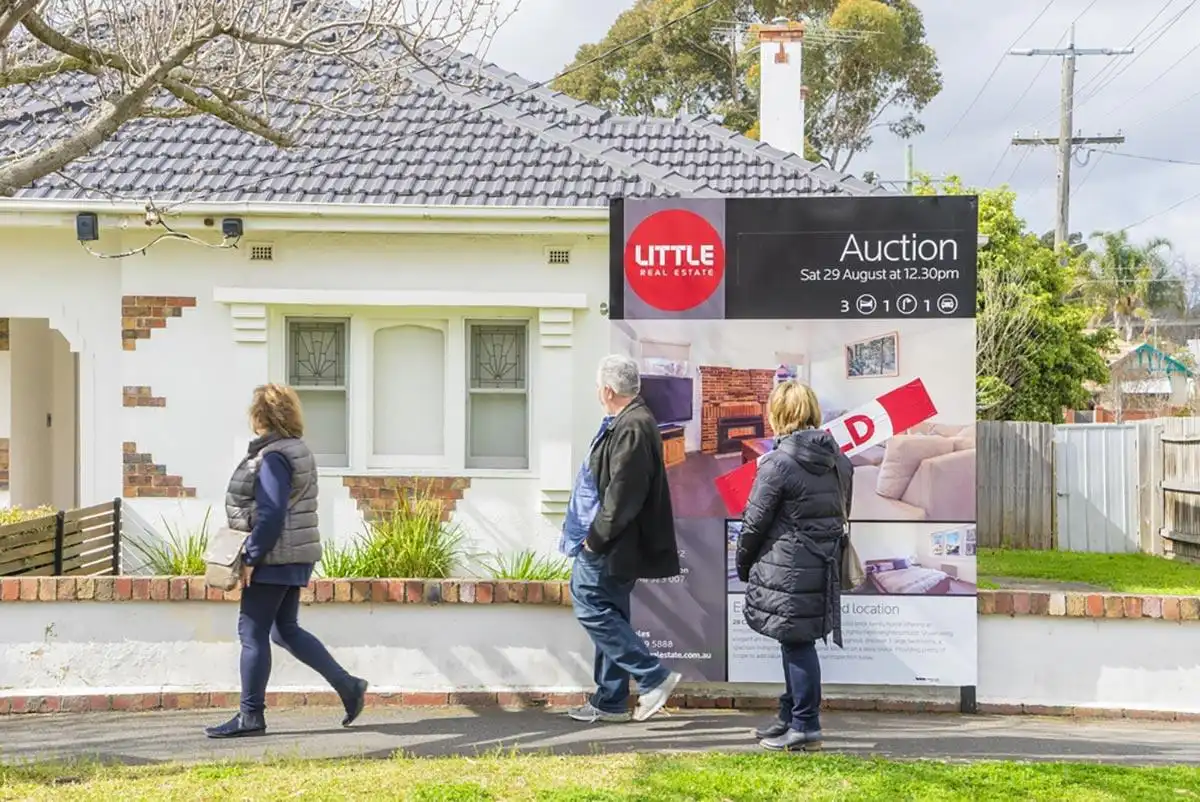Property price dips to 'become more widespread' but may be short-lived
The Australian property market is shifting rapidly now as interest rates continue to rise and price growth slows and reverses. But how long will it last?
CoreLogic's latest report shows that every city and region has now passed its peak, and with inflation remaining high there may be a broad-based price correction on the horizon.
So what does it all mean for sellers and buyers in this turbulent time for property?
National property prices: June 2022
Houses$822,019Monthly change: -0.7%
Units$620,148Monthly change: -0.4%
CoreLogic's June 2022 figures show that nationally, the median property value fell by -0.6 per cent for the month.
That number comprises a large spread between the best and worst-performing markets.
| Market | Month | Quarter | Annual | Median Value |
|---|---|---|---|---|
| Sydney | -1.6% | -2.8% | 5.9% | $1,110,660 |
| Melbourne | -1.1% | -1.8% | 3.1% | $798,198 |
| Brisbane | 0.1% | 2.7% | 25.6% | $784,826 |
| Adelaide | 1.3% | 5.1% | 25.7% | $642,470 |
| Perth | 0.4% | 2.1% | 5.8% | $558,644 |
| Hobart | -0.2% | -0.1% | 13.7% | $735,936 |
| Darwin | 0.9% | 2.3% | 6.5% | $509,833 |
| Canberra | 0.3% | 1.5% | 16.3% | $937,568 |
| Combined capitals | -0.8% | -0.8% | 8.7% | $826,662 |
| Combined regional | 0.1% | 2.0% | 19.9% | $600,442 |
| Australia | -0.6% | -0.2% | 11.2% | $752,110 |
Sydney homes experienced the most significant price drop of -1.6 per cent for the month. Melbourne wasn't far behind with losses of -1.1 per cent.
Brisbane's extended boom looks to have finally eased, with June registering gains of just -0.1 per cent, while Adelaide continued its outstanding run with a further -1.3 per cent growth.
Perth's renewed upswing remained steady with +0.4 per cent gains for the month, as did Darwin's with a +0.9 per cent bump.
Hobart remained relatively flat with a -0.2 per cent reduction, and Canberra's pace slowed with movement of just +0.3 per cent.
After months of extended resilience, the regional markets look to have flattened as well, collectively gaining just +0.1 per cent for June.
Units look to be outperforming at present after a long period of houses dominating growth, likely a result of affordability pressures making units a more attractive option for homebuyers.
Most markets hit their peak in 2021
With many months of data gathered since the beginning of last year's property boom, CoreLogic has pinpointed the month of peak growth for every capital and state regional market.
The results, which calculate growth over a full three-month period to define the market peak, may be surprising.
| Region | 3 months to June 2022 | Peak rate of growth (3 month) | Month of peak growth |
|---|---|---|---|
| Sydney | -2.8% | 9.3% | 31/05/2021 |
| Melbourne | -1.8% | 5.8% | 30/04/2021 |
| Brisbane | 2.7% | 8.5% | 31/12/2021 |
| Adelaide | 5.1% | 7.4% | 31/01/2022 |
| Perth | 2.1% | 7.7% | 31/03/2021 |
| Hobart | -0.1% | 8.2% | 30/04/2021 |
| Darwin | 2.3% | 7.9% | 31/01/2022 |
| ACT | 1.5% | 7.3% | 31/08/2021 |
| Regional NSW | 1.5% | 7.8% | 31/05/2021 |
| Regional VIC | 1.2% | 7.1% | 30/04/2021 |
| Regional QLD | 2.6% | 6.7% | 31/01/2022 |
| Regional SA | 5.3% | 7.4% | 31/03/2022 |
| Regional WA | 2.0% | 7.9% | 31/01/2021 |
| Regional TAS | 3.2% | 7.7% | 31/08/2021 |
| Combined capitals | -0.8% | 7.1% | 31/05/2021 |
| Combined regions | 2.0% | 6.6% | 30/04/2021 |
| Australia | -0.2% | 7.0% | 31/05/2021 |
According to CoreLogic's findings, Sydney and Melbourne (and their regional counterparts) hit their peak growth periods over 12 months ago and have been cooling off ever since.
Perth and Hobart also peaked early in 2021, while Brisbane and Adelaide hit their tops around the 2021/22 new year period.
Regional SA is the most recent market to reach peak growth, gaining a massive +7.4 per cent in the three months to March 2022.
With the market as a whole now firmly in a downturn phase, it may be a long time before these levels of peak growth are seen again in Australia.
Listings are trending up but no signs of 'panicked selling'
Overall, listings are on the rise, but it's a very mixed bag between different cities and regions.
Supply in Sydney and Melbourne is up significantly, and that's a key contributing factor to the slowdown in those markets.
Listings have also shot up in Hobart and Canberra, while available stock remains low in Brisbane and Perth. In Adelaide, still the country's strongest market, advertised listings are nearly -40 per cent below the five-year average.
CoreLogic's research director Tim Lawless explained that rising supply is more to do with a reduction in sales and general seasonality than a rush of new listings to the market.
"We aren’t seeing any signs of panicked selling as housing conditions cool, in fact the trend is the opposite, with the flow of new listings to the market slowing," he said.
With the RBA announcing another +0.5 per cent increase to the cash rate this week, consumer sentiment continues to slump.
That's causing a reduction in buyer demand to the tune of -15.9 per cent fewer home sales in the June quarter when compared to 2021.
Even so, national sales are still +13.0 per cent higher than the five-year average, so there is no shortage of transacting happening across the Australian property market.
Regional markets are now feeling the pinch but may rebound
While a number of Australia's capital city markets have seen growth rates slowing for a year or more now, regional locations have managed to retain a lot of their heat.
June's results finally show that growth in every regional market aside from SA has more or less flattened.
| Market | Month | Quarter | Annual | Median Value |
|---|---|---|---|---|
| Regional NSW | 0.0% | 1.5% | 21.1% | $745,904 |
| Regional VIC | -0.1% | 1.2% | 15.2% | $595,409 |
| Regional QLD | 0.2% | 2.6% | 21.9% | $563,546 |
| Regional SA | 1.8% | 5.3% | 22.3% | $337,064 |
| Regional WA | 0.2% | 2.0% | 8.9% | $404,100 |
| Regional TAS | 0.1% | 3.2% | 22.1% | $538,533 |
| Combined capitals | -0.8% | -0.8% | 8.7% | $826,662 |
| Combined regional | 0.1% | 2.0% | 19.9% | $600,442 |
It's part of an accelerating trend of cooling that's seen the regions broadly catching up to the downturn of capital city markets.
There may be significant further growth on the cards for some of the country's most desirable regional locations, though.
Ray White's chief economist Nerida Conisbee told the AFR that destinations like the Gold Coast, Sunshine Coast, Hunter Valley and Shepparton have all shown signs of extending their paths of price growth.
"At the rate prices are rising in these areas, it’s quite possible for them to climb by around 20 per cent this year," she said.
"Many regions are still on track for a 10 per cent rise this year, so I think the housing boom is definitely not over for areas that are relatively close to capital cities."
What's next for the Australian property market?
This week we saw the RBA raise the cash rate by another +0.5 per cent, another sharp increase that many economists predicted as part of the fight against runaway inflation.
As Mr Lawless noted, the fate of the Australian housing market is closely tied to how far and how fast interest rates do rise, as decreased borrowing power will directly affect buyer demand.
AMP Capital's Shane Oliver still expects the cash rate to peak at 2.5 per cent in the first half of 2023, a level which could result in property prices falling by 10 to 15 per cent.
If a 15 per cent decline were to materialise, that would bring property prices back down to April 2021 levels.
BuyersBuyers co-founder Pete Wargent sees the downturn being more short-lived, though, saying that inflationary pressures are now easing across the globe.
"The good news for borrowers is that the peak of the inflation hysteria now appears to have passed," he said.
While noting that Australia's inflation path is lagging behind other countries, he said consumers should be comforted by predictions of the RBA cutting rates again in 2023, and today's interest rates are still relatively very low.
Ultimately, every suburb, street and property is unique, so speaking to a top local agent to understand how your home will perform in the current market will help provide clarity in this time of change.








